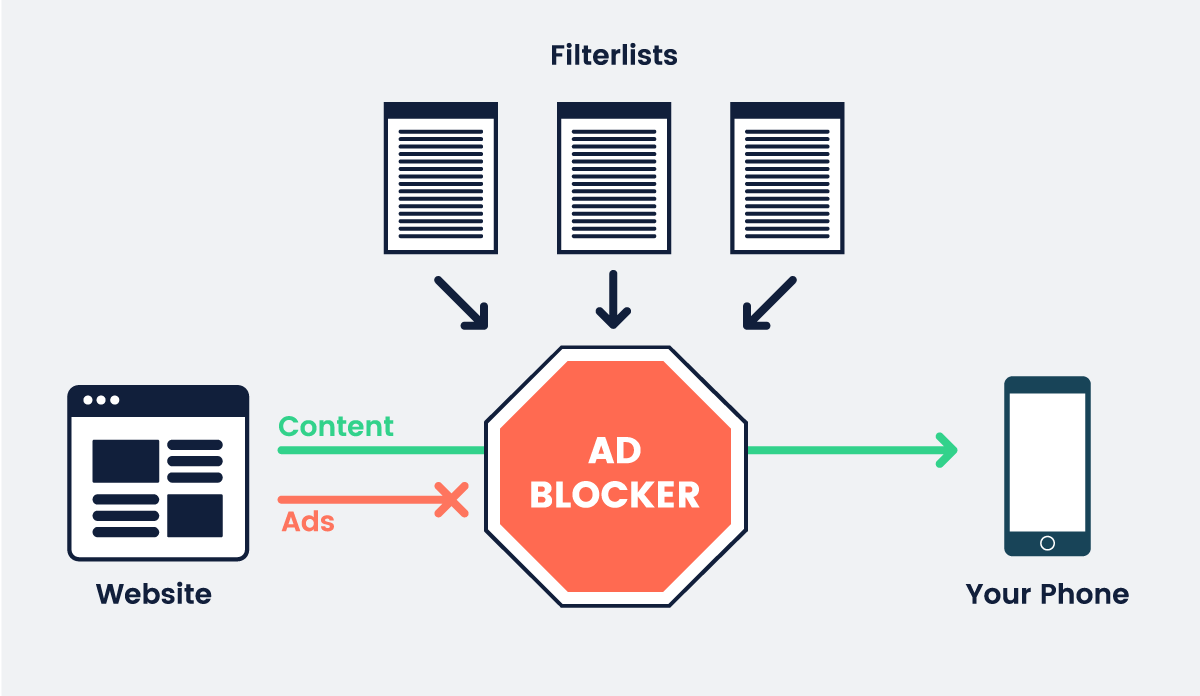There’s been a lot of chatter around ad blockers, especially since the announcement from both Apple and Google about installing ad blocking software to their Safari and Chrome browsers.
Something that’s still fairly new to the mix? Mobile ad blocking. As more and more traffic moves to mobile, there’s a sense that mobile ad blockers will become more relevant. But should advertisers be concerned? Can mobile ad blockers affect your social media advertisements?
We’ll take a deep dive into the topic to find out everything you need to know about this phenomenon.
Related: Everything you need to know about ad blockers.
What is mobile ad blocking?

The first mobile ad blockers were available on the internet as early as 2014. Today, there are a variety of apps that can be installed and used as web browser extensions on a user’s mobile device, blocking ads it deems “intrusive.”
Interruptions are one of the top reasons users will install an ad blocker. Ads that pop up, roll out to form a longer top banner or expand across a user’s screen prompts a poor user experience.
When using a mobile device, these ads will cause the viewer to turn away from websites or apps where these ads show up because it gets in the way of what they’re trying to do.
A report from PageFair reveals that security (30%), interruptions (29%), speed (16%) and an excessive amount of ads (14%) are the main reasons behind mobile ad blocking adoption.
A total of 380 million mobile devices were using ad blockers at the beginning of 2017.
The current state of mobile ad blocking
A total of 380 million mobile devices were using ad blockers at the beginning of 2017. This number is predicted to continue to rise, as well as the number of desktop ad blockers despite the decline in overall desktop usage.
The largest majority of mobile ad blocking adoption is occurring in the Asia-Pacific region, where the use of mobile surpasses the use of desktops. Currently, only 8% of the U.S. population uses mobile ad blockers, compared to 16% of the population in the APAC.
While in the U.S. ad blocker users want to get rid of intrusive ads, members of the APAC adopt mobile ad blockers because they have limited data plans. Blocking these ads for a month prevents users from hitting a pay cap with their browsing.
How ad blockers impact advertisers
As with most advertising, the potential for mobile ad blocking usage comes down to location, location, location. If you’re targeting China, India or Indonesia, there’s a much higher risk of your ads being blocked on mobile devices. As mentioned earlier, limited data plans are the main reason for ad blockers large adoption at APAC.
As for the U.S. market, users aren’t opposed to viewing ads that are respectful or relevant. This leads to improving both the quality and the targeting of the ads you’re sending out. Listen to why your audience is choosing to block ads, fix the problem and serve them a solution.
You should also work to gain customers’ trust in your brand or business, so they will find your ads less intrusive to their mobile experience.
Related: Creating a mobile-first ad strategy
Ad blockers and social media advertising
Some of the most popular ad blockers such as Adblock Plus do have the ability to block some social ads, like YouTube and Facebook videos, when users visit these pages through a web browser rather than the app itself.
However, these platforms do offer ways to ensure advertisers’ work is not hidden, which makes social media advertising a safe bet if you want to reduce the risks of having your ads affected by mobile ad blockers.
Here are the main advantages:
- Social media allows users to hide ads, but also give feedback. Facebook, Twitter and Instagram allow users to select whether they want to hide an ad or see fewer ads of a certain kind.
- You have a variety of innovative ad formats available that make for high-quality, engaging posts. Just remember to stick to Facebook’s 20% text rule to avoid having your ads look like spam.
- With social media, users also have the option to scroll at will, meaning there are no ads that block the viewer’s feeds or that they have to watch for x amount of time in order to continue. This strategy increases the chances of success because the ads blend naturally with the content on user’s feeds.
Because mobile ad blockers are mostly used as an extension to web browsers, ads in mobile and desktop apps are mostly immune to ad blockers.
Ad blockers can’t get in the way of an ad that shows up between users’ stories on Snapchat or Instagram, sponsored content or inMails and Twitter cards, for example. As a result, social media will become a threshold for advertisers to continue reaching their intended audience.
The downside is that competition on social media tends to increase as social media platforms add more and more high-quality ad formats, which can impact the cost of advertising on social. Creating a detailed target plan, then, becomes even more important to allow advertisers to make the most of their budget while delivering ads to the audience that is actually interested in seeing them.
Things not to be blocked from your memory
Users install ad blockers in order to have an uninterrupted experience while browsing on the web, which means you don’t want to be the intrusion that incentivizes them to adopt mobile ad blocking.
Keep the customer as your focus rather than only your advertisements and how far you can push them. Use social media advertising as a way to reach your most valuable audience and deliver your ads to people who are interested in them.








